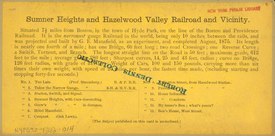Sumner Heights and Hazelwood Valley Railroad
| Sumner Heights and Hazelwood Valley Railroad | |
|---|---|
|
Description of the route
| |
| Route length: | 0.4 km |
| Gauge : | 254 mm |
| Maximum slope : | 116 ‰ |
| Minimum radius : | 4.3 m |
| Top speed: | 40 km / h |
The Sumner Heights and Hazelwood Valley Railroad was an experimental narrow-gauge railway with the unusually narrow gauge of only 10 inches (254 mm) which was commissioned near Boston in 1875 .
Location and route construction
The Sumner Heights and Hazelwood Valley Railroad led in the city of Hyde Park , 11.7 km from Boston, to the railway line of the Boston and Providence Railroad . It was relocated by George E. Mansfield as part of an experiment and completed in August 1875. At that time it was supposedly the light railroad with the narrowest gauge in the world.
The route began at the top of a small hill at Hazelwood Station on the Providence Railroad. After winding its way around the hill in sharp turns, it led down the hill through Mr. Mansfield's back yard and in a seemingly very dangerous curve diagonally across a street, just past another street corner over a small bridge and then over one another road to the railroad, which she followed for a short distance.
It was almost 0.4 km long, had a 18.3 m long bridge, two level crossings, an S-curve, a switch, a siding and a junction. The longest straight was 15.25 m long. The maximum slope was 116 ‰, the average slope 53 ‰. The narrowest arcs were 14, 25, and 43 foot (4.3, 7.6, and 13.1 m) radiuses. The arch on the bridge was 126 feet (38.4) in radius with a 60 ‰ slope.
The sleepers consisted of narrow, 25 mm thick boards about 380 mm long to which wooden rails made of 25 × 25 mm softwood slats were nailed with a gauge of 250 mm (10 inches) with small nails. Narrow strips of thin steel band were nailed to the rails .
Cars and their operation
The weight of the carts was 100 and 150 pounds (45 and 68 kg). They could carry more than six times their own weight, and that at a speed of 40 km / h (25 mph). One of the cars used on this route was a bogie car that was about 61 cm wide and 1.5 m long.
The car wheels were 130 mm (5 inches) in diameter. So that the wheels of the cars with their small flanges did not derail in the tight bends, they were connected to the car in a special way invented by the designer Mansfield. The small wheels followed the curved track in any wind and weather as safely as if they had a much larger diameter and correspondingly larger wheel flanges.
Four adult men could ride in the car, which was rolling downhill by gravity but could be braked completely. Those who drove with it were surprised that there was no vibration. The fastest descent took just 45 seconds including acceleration and braking. At first glance it seems that the train was just a children's toy, and a dangerous one, but a closer examination of its capabilities led to a positive assessment.
Individual evidence
- ↑ a b c d J.W. and JS Moulton: New Series, American Views: Sumner Heights and Hazelwood Valley Railroad and Vicinity.
- ↑ a b c d e f Howard Fleming: Narrow gauge railways in America. A sketch of their rise, progress and success: valuable statistics as to grades, curves, weight of rail, locomotives, cars, etc. p. 38.
Coordinates: 42 ° 15 '20 " N , 71 ° 7' 28" W.


